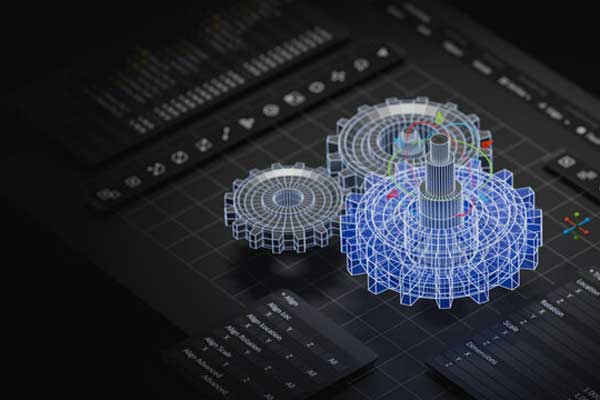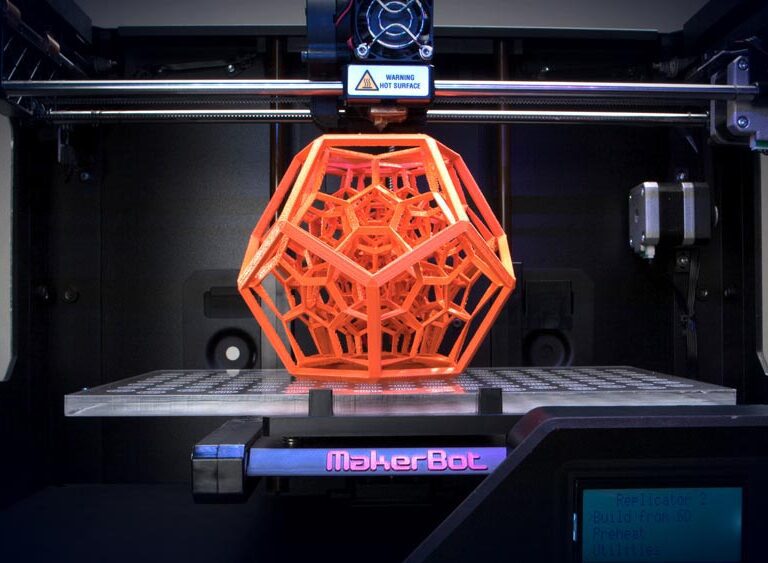In this succinct article, I delve into the diverse landscape of software options available to product designers. Whether you’re a seasoned professional or just starting out, I’ll guide you through the tools that can elevate your design process. From ideation to high-fidelity creations, let’s explore the best solutions tailored to your needs.
Table of contents:
- Introduction
-
- The Importance of Choosing the Right Software for Product Design
- Understanding Product Design
- Definition and Importance of Product Design
- The Role of Software in Product Design
- Factors to Consider When Choosing Product Design Software
-
- Budget
- Usability
- Features
- Compatibility
- Support and Community
- Sketching Software
-
- Adobe Illustrator & Photoshop
- Krita
- Autodesk sketchbook
- Review of Popular Product Design Software – 3D Modeling
-
- Blender3D – 3DsMax – Maya – C4D
- Rhino 3D
- Fusion360
- Solidworks
- Autodesk Inventor
- Review of Popular Product Design Software – Render and presentation
-
- Keyshot
- V-Ray
- Unreal engine and Unity
- Other Render Engines
- Substance 3D Painter
- Adobe Illustrator & Photoshop
- My journey to finding the best software
-
- Success Stories of Using the Right Software
- Lessons Learned from Using the Wrong Software
- Combination of software
-
- 1st combo: Concept design
- 2nd combo: Design and prototype
- 3rd combo: Organic surface related products
- The Future of Product Design Software
-
- Emerging Trends
- Impact of Technology Advancements (AI, VR, etc.)
- Conclusion
-
- Key Takeaways
- References
1. Introduction
The Importance of Choosing the Right Software for Product Design
The importance of selecting the right software for product design cannot be overstated. In the dynamic landscape of innovation, product design software serves as the digital canvas where groundbreaking ideas take shape. It’s the modern-day workshop where designers, engineers, and creatives collaborate to mold and perfect the products that will shape our future. As technology advances, the role of this software extends beyond mere sketching and rendering. It now provides comprehensive solutions that streamline the entire product development process. Here’s why choosing the right software matters:
- Efficiency and Creativity Fusion: Product design software bridges creativity and efficiency. It inspires groundbreaking innovation while expediting the journey from idea to final product. By providing a digital environment for drafting, refining, and evaluating designs, it reduces the need for physical prototypes and costly iterations. This results in shorter development cycles, cost savings, and enhanced product quality.
- Comprehensive Capabilities: Product design software encompasses an array of tools and features. These include drawing and modeling utilities, simulation and analysis functions, and collaboration capabilities. Designers can work seamlessly within this ecosystem, ensuring the resultant product aligns with stipulated specifications and requirements.
- Types of Product Design Software:
-
- 2D Design Software: These programs focus on creating two-dimensional designs, essential for graphic design, vector-based illustration, and layout design. Examples include Adobe Illustrator and CorelDRAW.
- 3D Design Software: Specializing in three-dimensional models, these tools find extensive use in mechanical engineering, architecture, and industrial design. Notable examples are SOLIDWORKS, Autodesk Fusion 360, and Rhino.
Choosing the right software empowers designers to sail confidently in the world of product creation, turning visions into tangible reality. Whether it’s free open-source options like Blender or specialized platforms like Solidworks and Autodesk Inventor, the decision impacts not only the design process but also the future of innovation.
2. Understanding Product Design
Definition of Product Design:
Product design is the dynamic process that brings a product to life by considering its functionality, aesthetics, and user experience. It’s the harmonious blend of art, science, and technology, resulting in intuitive and visually appealing products that meet specific user needs and contribute to business success. This multidisciplinary field intersects with UX and UI design, engineering, and product management, fostering collaboration and innovation.
Importance of Product Design:
- Enhancing User Experience:
- Well-designed products resonate with users. Whether it’s the sleek lines of a smartphone or the ergonomic handle of a kitchen appliance, good design makes interactions enjoyable.
- Intuitive interfaces, seamless navigation, and thoughtful features contribute to positive user experiences, fostering customer loyalty and satisfaction.
- Driving Innovation and Creativity:
- Product design serves as a playground for creativity. It encourages experimentation with new materials, technologies, and concepts.
- By pushing boundaries, businesses discover novel solutions and stay ahead in competitive markets.
- Establishing Brand Recognition:
- Iconic designs become synonymous with brands. Think of Apple’s minimalist aesthetics or Coca-Cola’s timeless bottle shape.
- A well-designed product reinforces brand identity, making it instantly recognizable and memorable.
- Reducing Costs:
- Effective product design minimizes waste, streamlines manufacturing processes, and optimizes resources.
- Thoughtful design choices lead to cost savings in production, assembly, and maintenance.
In summary, product design isn’t just about aesthetics; it’s a strategic investment that impacts user satisfaction, brand reputation, and business growth. So, whether you’re crafting digital experiences or tangible goods, prioritize design—it’s your gateway to success.
3. Factors to Consider When Choosing Product Design Software
- Budget
Design software, akin to any other product, comes with a price tag. In the bustling marketplace of digital tools, myriad licensing options cater to diverse user requirements. Whether you’re a fledgling designer, a seasoned architect, or a visionary entrepreneur, there’s a licensing tier tailored just for you. These tiers span from individual licenses to enterprise packages, ensuring accessibility across the spectrum of creative minds.
But wait, there’s more! Beyond the commercial behemoths, a constellation of free and open-source programs twinkles on the horizon. These gems democratize creativity, empowering enthusiasts and startups without hefty budgets. In the following paragraphs, I’ll unveil these stellar contenders—software constellations that beckon you to explore, ideate, and craft without constraints.”
- Usability
It is very important to know what do you exactly want from a design software. Do you want to create action figures or something like that? Or you want to create daily functional products like a phone mount. Some of software available like Blender3D or ZBrush gives you the right tools to create organic surfaces with ease, and other software like Solidworks will let you consider all manufacturing needs and techniques that you need (for example all kind of nuts, bolts, screws, surface analysis and so much more).
So first of all, you need to know what you want to make. An organic surface product or a hard surface one with accurate dimensions and tolerance.
Understanding your precise design goals is paramount when selecting software. Are you envisioning intricate action figures or perhaps functional everyday items like a phone mount? The software landscape offers a diverse palette, each brushstroke catering to distinct needs.
- Organic Surfaces and Artistic Expression:
- Blender3Dand ZBrush emerge as virtuoso tools for sculpting organic forms. Their intuitive interfaces empower artists to breathe life into digital clay, shaping curves, textures, and intricate details with grace.
- Whether it’s the sinuous contours of a character’s face or the undulating folds of fabric, these software options grant creative freedom.
- Precision Engineering and Manufacturing Considerations:
- SolidWorks, on the other hand, dons the mantle of precision. It’s the drafting table where engineers and industrial designers converge.
- Here, every nut, bolt, and screw align meticulously. Surface analyses, material properties, and manufacturability take center stage.
- If your vision involves hard surfaces—machined components, enclosures, or architectural elements—SolidWorks stands ready.
So, step one: Define your design destination. Are you embarking on an odyssey of organic surfaces or navigating the precise coordinates of engineering rigor? Your choice will shape not only your designs but also the world they inhabit.
- Features
- User Interface (UI) and Workflow:
- Intuitive Interface: A well-designed UI enhances productivity. Look for software with a clean layout, customizable menus, and efficient navigation.
- Workflow Efficiency: Consider how seamlessly the software integrates into your existing workflow. Does it support collaboration, version control, and easy file sharing?
- Modeling Capabilities:
- Parametric Modeling: Software like SolidWorksexcels in parametric modeling. It allows you to create designs based on parameters, making changes and iterations a breeze.
- Sculpting and Organic Modeling: If you’re sculpting characters, creatures, or artistic forms, explore tools like ZBrushor Blender3D. These excel in organic surfaces.
- Analysis and Simulation:
- Finite Element Analysis (FEA): For engineering applications, FEA tools within software like ANSYSor COMSOL are indispensable. They predict structural behavior and stress distribution.
- Fluid Dynamics Simulation: If your designs involve fluid flow (think aerodynamics or water flow), look for software with robust fluid dynamics modules.
- Rendering and Visualization:
- Realistic Rendering: High-quality rendering engines like KeyShotor V-Ray transform 3D models into photorealistic images. Visual appeal matters!
- Animation and Walkthroughs: Some software allows you to create animations or interactive walkthroughs. Useful for presentations and marketing.
Remember, the right software aligns with your vision, amplifying your creative prowess. Whether you’re sculpting dreams or engineering precision, choose wisely!
- Compatibility
- Operating System Compatibility:
- Consider the operating system (OS) you’re using. Some software is exclusive to Windows, while others thrive on macOS or Linux.
- SolidWorks, for instance, predominantly caters to Windows users, whereas Fusion 360spans multiple platforms.
- File Format Interoperability:
- Import and Export: Ensure the software supports common file formats. Look for compatibility with industry standards like STEP, IGES, and STL.
- Collaboration: If you collaborate with others, seamless file exchange is vital. Choose software that aligns with your team’s tools.
- Hardware Requirements:
- Resource Demands: Different software has varying hardware requirements. Some demand powerful GPUs and ample RAM, while others are more forgiving.
- Cloud-Based Solutions: Cloud-based tools like Onshapealleviate local hardware constraints.
- Integration with Other Tools:
- Ecosystem Harmony: Does the software play well with other tools you use? Integration with design libraries, rendering engines, or simulation software matters.
- Plugins and Extensions: Explore available plugins and extensions. They enhance functionality and streamline workflows.
- Industry Standards and Practices:
- Industry-Specific Software: Certain fields favor specialized software. Architects lean toward AutoCAD, while game designers embrace Unityor Unreal Engine.
- Compliance: If your work aligns with specific industry standards (e.g., ISO certifications), ensure the software complies.
Remember, compatibility isn’t just about software—it’s about harmonizing your creative journey with the digital symphony of tools at your disposal. Choose wisely, and may your designs flourish!
- Support and community
- Official Support Channels:
- Responsive Customer Support: When you encounter roadblocks or have technical queries, reliable customer support is invaluable. Look for software providers that offer timely assistance via email, chat, or phone.
- Documentation and Knowledge Base: Well-organized documentation, FAQs, and user manuals enhance your self-help journey. A robust knowledge base can be your compass through software intricacies.
- User Communities and Forums:
- Active User Forums: Seek out vibrant online communities where fellow users share insights, troubleshoot issues, and exchange tips. These forums often harbor hidden gems and workarounds.
- Social Media Groups: Platforms like Reddit, Stack Exchange, and LinkedIn host specialized groups for software enthusiasts. Join these digital watering holes to tap into collective wisdom.
- Tutorials and Learning Resources:
- Video Tutorials: Platforms like YouTube host a treasure trove of video tutorials. From basic navigation to advanced techniques, these visual guides accelerate your learning curve.
- Online Courses: Consider enrolling in structured courses on platforms like Udemy, Coursera, or LinkedIn Learning. Expert instructors guide you through the software’s nuances.
- Third-Party Plugins and Extensions:
- Community-Developed Plugins: Some software ecosystems thrive on third-party plugins. These extend functionality, adding features not native to the core software.
- Custom Scripts and Macros: If you’re an advanced user, delve into scripting. Custom macros can automate repetitive tasks and unlock hidden potential.
- User Feedback and Software Updates:
- Feedback Channels: Does the software provider actively seek user feedback? Regular updates based on user input indicate a responsive development team.
- Version History: Investigate the software’s update history. Frequent updates signal ongoing improvements and bug fixes.
Remember, a robust support network isn’t just a safety net—it’s a launchpad for your creative endeavors. Choose software that embraces you as part of its digital family!
4. Sketching Software
1) Adobe Photoshop:
Photoshop reigns as the industry-standard photo editing software.
- Pixel Powerhouse:
- Raster-based images thrive here. Photoshop handles detailed colors, shading, and precise edits.
- From retouching to mind-bending photo art, it’s your canvas.
- Photo Composites and Collages:
- Layer images, blend elements, and create magic.
- Craft original visuals from different photo files.
- Raster Graphics Brilliance:
- Photoshop’s pixel-based approach excels in detailed textures.
- Ideal for enhancing photos, correcting lighting, and making subjects look their absolute best.
- Seamless Integration with Illustrator:
- Both apps play well together within Adobe Creative Cloud.
- Illustrator’s vector art can fit into larger Photoshop projects, and vice versa.
In my opinion Photoshop is a good choice for digital sketch and package while illustrator will be a good tool for designing package or any type of brand identity graphics that you need.
2) Krita
Krita | The Free and Open-Source Canvas
- Purpose: Krita is a free, open-source program tailored for digital illustration, animation, and painting.
- Digital Painting: It’s a playground for artists, offering an impressive brush library and customizable tools.
- Ease of Use: Krita’s flow is akin to Photoshop but simpler, making it accessible for beginners.
- Compatibility: Works across various operating systems.
- Pricing: Krita wins here—it’s free!
- Photoshop vs. Krita: The Showdown:
- Features: Photoshop is a powerhouse with an extensive feature set, including camera raw and other tools for photo editing. Krita does less but excels in digital painting and sketching.
- Usability: Krita’s user-friendly interface lets you dive in without getting lost.
- Support: Photoshop’s robust support system trumps Krita’s volunteer-run service.
- Users: Photoshop boasts a broader user base, while Krita caters to hobbyists and illustrators.
- Longevity: Adobe Photoshop’s business-driven innovation ensures long-term viability.
In summary, Krita is the free-spirited sibling, perfect for digital artists, while Photoshop remains the industry standard for graphic design and photo manipulation. Choose wisely based on your creative journey!
2) SketchBook
Autodesk Sketchbook is a powerful tool that caters to digital artists, illustrators, and designers. Here’s why it stands out:
- Intuitive User Interface (UI):
- SketchBook boasts an incredible UIthat feels like an extension of your creativity. The interface is clean, customizable, and designed for seamless navigation.
- Whether you’re a seasoned artist or a beginner, the intuitive layout ensures a smooth workflow.
- Customizable Brushes and Tools:
- The brush library in SketchBook is a treasure trove. From realistic pencils to vibrant watercolors, you’ll find the perfect brush for every stroke.
- Customize brushes, adjust opacity, and experiment freely.
- Professional-Grade Perspective Tools:
- Architects, concept artists, and illustrators benefit from SketchBook’s perspective tools. Create accurate vanishing points, grids, and 3D scenes effortlessly.
- Achieve depth and realism in your designs.
- Cross-Platform Compatibility:
- SketchBook works seamlessly across various platforms—Windows, macOS, iOS, and Android.
- Sync your work across devices and continue your creative journey wherever you go.
- Affordability and Potential:
- Unlike some premium software, SketchBook is inexpensive. It offers incredible value for its price.
- Whether you’re sketching, painting, or creating concept art, SketchBook has the potential to elevate your work.
In my opinion sketchbook is the fastest and most user-friendly software for digital sketch. You almost don’t need to learn anything in this software. When you open sketchbook for the first time everything is familiar to you, there isn’t any unnecessary tools or feature, everything and every tool is there if it is only related to sketching and nothing else.
In summary, Autodesk SketchBook is a unique blend of power, simplicity, and artistic freedom. Whether you’re a hobbyist or a professional, this canvas awaits your imagination!
5. Review of Popular Product Design Software – 3D Modeling

- Blender3D – 3DsMax – Maya – C4D
- Rhino 3D
- Fusion360
- Solidworks
- Autodesk Inventor
In the following tables I mentioned every good software available in the market in a short but useful way.
Blender 3D
- 3D Modeling Capability:
- Blender3D: Robust modeling capabilities, including parametric design using modifiers and nodes.
- 3DsMax: Excellent for modeling, texturing, and meshing. Not inherently parametric.
- Maya: Primarily geared toward animation but offers solid modeling features.
- Cinema4D: Strong modeling tools, especially for creative applications.
- Rhino 3D: NURBS-based modeling, precise curves, and freeform surfaces.
- Fusion 360: Parametric modeling with history-based design.
- Solidworks: Industry standard for parametric modeling, especially for mechanical design.
- Autodesk Inventor: Specialized for product design and engineering.
- User Interface (UI):
- Blender3D: Customizable UI, suitable for both beginners and experts.
- 3DsMax: Clean interface, automation features.
- Maya: Versatile UI, used in film, TV, and games.
- Cinema4D: User-friendly, intuitive layout.
- Rhino 3D: Navigable interface, especially for NURBS modeling.
- Fusion 360: Modern UI, cloud-based collaboration.
- Solidworks: Industry-standard UI for mechanical design.
- Autodesk Inventor: Familiar interface for engineers.
- Analysis and Simulation:
- Blender3D: Limited built-in simulation tools.
- 3DsMax: Offers fluid, particle, and physics simulations.
- Maya: Extensive simulation capabilities (fluids, cloth, dynamics).
- Cinema4D: Good for creative simulations (cloth, smoke, fire).
- Rhino 3D: Lacks advanced simulation tools.
- Fusion 360: Simulation for mechanical designs.
- Solidworks: Robust simulation for engineering.
- Autodesk Inventor: Simulation for product design and engineering.
- Rendering and Visualization:
- Blender3D: Cycles X for fast rendering.
- 3DsMax: V-Ray integration, photorealistic rendering.
- Maya: Arnold renderer, widely used in VFX.
- Cinema4D: Advanced rendering options.
- Rhino 3D: Basic rendering capabilities.
- Fusion 360: Real-time rendering.
- Solidworks: Basic rendering, focused on engineering.
- Autodesk Inventor: Limited rendering features.
- Operating System Capability:
- All tools support Windows, some also on macOS and Linux.
- Hardware Requirements:
- Vary by tool, but generally require multicore CPUs, 4-8 GB RAM, and dedicated GPUs.
- File Format Interoperability:
- All tools support common formats (STL, STEP, IGES).
- Industry Standards Capability:
- Solidworksand Autodesk Inventor excel in engineering.
- Mayadominates film and animation.
- Tutorials and Courses (Community):
- Blender3D: Abundant tutorials and active community.
- Mayaand 3DsMax: Extensive learning resources.
- Cinema4D: Growing community.
- Rhino 3D: Niche community.
- Fusion 360: Autodesk’s resources.
- Solidworksand Autodesk Inventor: Industry-specific training.
- Open Source or Third-Party Plugins:
- Blender3D: Open source, extensive plugin support.
- Others: Limited open-source options, but plugins available.
- Pricing and Licenses:
- Blender3D: Free and open-source.
- Others: Commercial licenses, varying costs.
Choose wisely based on your specific needs and industry focus!
6. Review of Popular Product Design Software – Render and presentation
- Keyshot
- V- Ray
- Unreal engine and Unity
- Other Render Engines
- Substance 3D Painter
- Adobe Illustrator & Photoshop
1) KeyShot
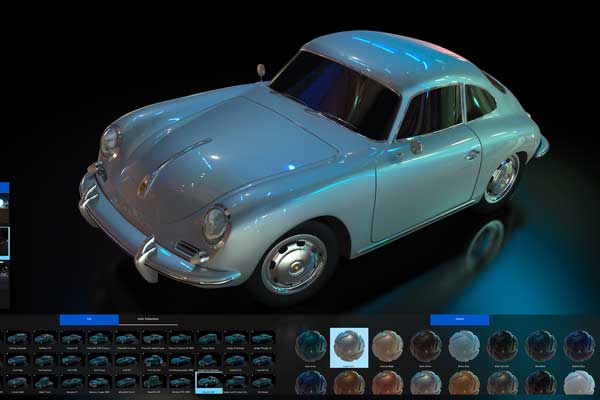
- Realism and Output Quality: KeyShot provides high-quality, realistic renders with real-time feedback.
- User Interface: KeyShot has an intuitive, user-friendly interface.
- Analysis and Simulation: Limited simulation capabilities.
- Rendering and Visualization: Excellent for product visualization and marketing materials.
- Operating System Capability: Works on both Windows and macOS.
- Hardware Requirements: Not resource-intensive; runs on most systems.
- File Format Interoperability: Supports various file formats.
- Industry Standards Capability: Commonly used in product design and marketing.
- Tutorials and Courses: Active community and online tutorials.
- Open Source or Plugins: Not open source, but supports plugins.
- Pricing and Licenses: Commercial licenses, annual subscription model.
2) V-Ray
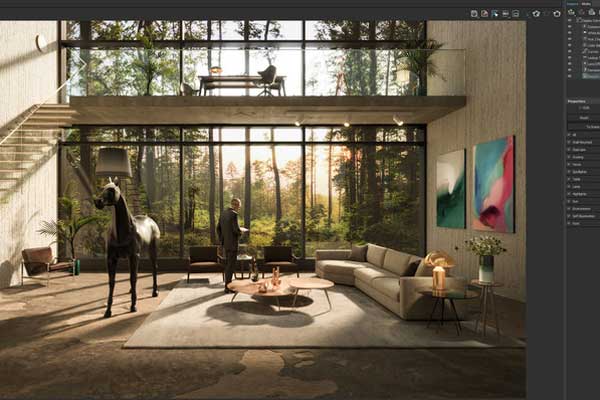
- Realism and Output Quality: V-Ray offers photorealistic rendering with advanced features.
- User Interface: Complex UI, integrates with various 3D software.
- Analysis and Simulation: Extensive simulation capabilities (fluids, particles, etc.).
- Rendering and Visualization: Widely used in architectural visualization and film.
- Operating System Capability: Available on Windows, macOS, and Linux.
- Hardware Requirements: Requires powerful GPUs and CPUs.
- File Format Interoperability: Supports common formats.
- Industry Standards Capability: Strong presence in architectural visualization.
- Tutorials and Courses: Abundant resources available.
- Open Source or Plugins: Not open source, but supports plugins.
- Pricing and Licenses: Commercial licenses, varying costs.
3) Unreal Engine and Unity

Unreal engine is a game engine but it can be used as a good real time render engine
- Realism and Output Quality: Both engines offer high-quality real-time rendering.
- User Interface: Unreal Engine has a complex UI, while Unity is more user-friendly.
- Analysis and Simulation: Unreal Engine excels in interactive simulations.
- Rendering and Visualization: Used in gaming, virtual reality, and architectural visualization.
- Operating System Capability: Both support Windows and macOS.
- Hardware Requirements: Require powerful GPUs for real-time rendering.
- File Format Interoperability: Support common formats.
- Industry Standards Capability: Unreal Engine dominates gaming and film.
- Tutorials and Courses: Abundant resources for both engines.
- Open Source or Plugins: Both have active communities and support plugins.
- Pricing and Licenses: Unreal Engine is free with royalties; Unity has various licensing options.
4) Substance 3D Painter
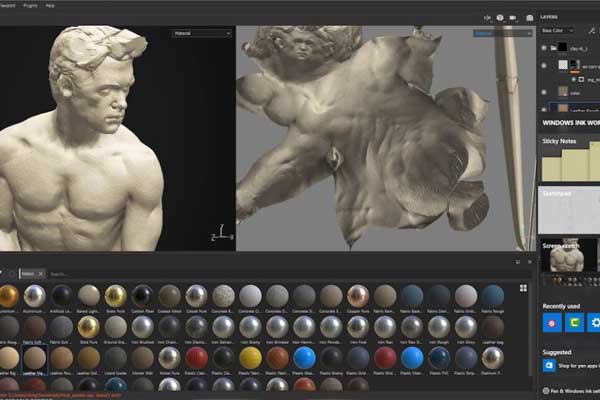
Substance Painter
- Realism and Output Quality: Excellent for texturing and material creation.
- User Interface: User-friendly, node-based interface.
- Analysis and Simulation: Not for simulation; focused on texturing.
- Rendering and Visualization: Used in game development and film.
- Operating System Capability: Available on Windows and macOS.
- Hardware Requirements: Moderate hardware requirements.
- File Format Interoperability: Supports various formats.
- Industry Standards Capability: Commonly used in game development.
- Tutorials and Courses: Active community and tutorials.
- Open Source or Plugins: Not open source, but supports plugins.
- Pricing and Licenses: Commercial licenses, subscription-based.
5) Adobe Illustrator & Photoshop
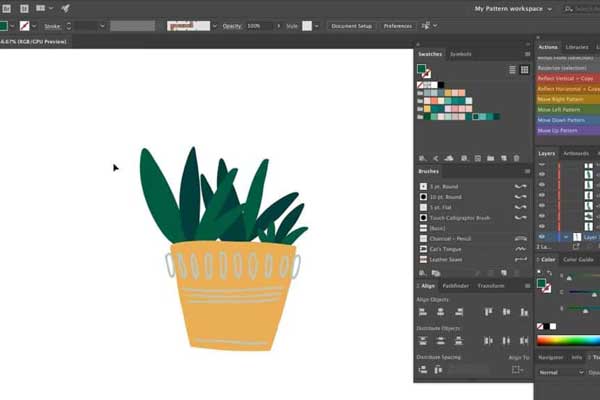
- Realism and Output Quality: Photoshop excels in photo manipulation; Illustrator for vector graphics.
- User Interface: Both have user-friendly interfaces.
- Analysis and Simulation: Not for simulation; focused on design and editing.
- Rendering and Visualization: Used in graphic design, advertising, and digital art.
- Operating System Capability: Available on Windows and macOS.
- Hardware Requirements: Moderate hardware requirements.
- File Format Interoperability: Support common formats.
- Industry Standards Capability: Widely used in design and creative industries.
- Tutorials and Courses: Abundant resources for both.
- Open Source or Plugins: Not open source, but supports plugins.
- Pricing and Licenses: Commercial licenses, subscription-based.
Choose the tool that aligns best with your specific needs and workflow!
7. My journey to finding the best software
Success Stories of Using the Right Software
As I prepared to begin my bachelor’s studies in Industrial Design, I took the initiative to sign up for a Rhino3D course. At that time, I had no prior experience with this type of software, and Rhino served as my entry point into understanding 3D space and its applications. Over the course of a year, I immersed myself in Rhino, exploring its capabilities.
However, when I started searching for local jobs in the CAD field, I noticed a prevailing preference for Solidworks. Curious, I inquired why this was the case. The response was straightforward: “We have extensive experience with Solidworks, and it offers a wealth of resources—tutorials, expert knowledge, and ready-to-use models.” Intrigued, I decided to delve into learning Solidworks.
Surprisingly, my transition to Solidworks was smoother than expected. Having already grasped the fundamentals of 3D space and its vocabulary (including terms like fillet, chamfer, and extrude), I adapted quickly. Solidworks, with its myriad features, is a powerful software suite. While achieving mastery may take considerable time, entering the job market or using it for personal or university projects doesn’t require an extensive commitment. In fact, dedicating just 1 month and spending 2-3 hours per day can yield significant results.
My advice? Begin by mastering the basics, and let the more advanced aspects unfold gradually. Time, indeed, is the best teacher. Continuously challenge yourself, seek knowledge through research, and consider leveraging AI assistance when needed.
After a year and a half, I found myself revisiting the initial motivation that led me into the field of Industrial Design. My unwavering goal had always been to become a transportation designer. At that moment, armed with a solid grasp of 3D modeling using Rhino and Solidworks, I realized that creating a car model within these software packages would demand an enormous investment of time. My attempt at modeling my very first car design in Rhino took two months, and the results were far from satisfactory. The surface quality was lacking, plagued by multiple trims and splits.
It was during this period of reflection that I recognized the need for specialized software tailored specifically to transportation design—a tool that could deliver superior quality in a more efficient process. My search led me to two promising options: Blender3D and Alias Auto Studio.
Let’s delve into what I discovered:
- Blender3D: This mesh-based program stood out for its speed and flexibility. Mesh-based software allows designers to shape forms with ease, unencumbered by rigid constraints. Blender3D, in particular, offered several compelling advantages:
- Freedom: It liberates designers from the confines of predefined frames, allowing them to explore their creativity.
- Speed: The process is lightning-fast, enabling rapid iterations and adjustments.
- Community: Blender boasts a vibrant and extensive community. If you encounter any roadblocks, there’s a 99% chancethat a helpful tutorial or discussion topic exists to guide you.
Notably, Blender3D is not only free and open-source, but it also has a minimal impact on system resources. Its lightweight nature ensures smooth performance even on modest hardware.
- Alias Auto Studio: As the industry standard for transportation design, Alias Auto Studio commands respect. However, it comes with its own set of challenges. Learning Alias is a formidable task, especially when compared to the relatively accessible Blender. But my ambitions extended beyond transportation design—I wanted to create characters, robots, and diverse 3D models. Hence, I made a deliberate choice: I would master Blender first.
In summary, my journey involved weighing the allure of industry standards against the practicality of a versatile, community-driven tool. Blender3D won my heart, and it continues to serve as my creative companion on this exciting design voyage.
Throughout my journey, I’ve explored various software tools for presentation and rendering. Initially, I stumbled upon the concept of “rendering” and sought a solution to enhance the visual appeal of my 3D models. That’s when I discovered KeyShot—an expensive standalone render engine that seamlessly integrated into my workflow. With KeyShot, I could effortlessly apply materials, adjust camera angles, and hit the render button to achieve stunning results.
KeyShot served as my primary rendering software, complemented by Photoshop for post-processing tasks. I meticulously fine-tuned colors, combined renders, and added text and titles to elevate my presentations. However, my trajectory shifted when I delved into Blender. This powerful 3D software introduced me to its native render engines: Cycles and EEVEE. Suddenly, exporting objects to KeyShot became unnecessary. I could design directly within Blender, leveraging its efficient render engines—no more export-related headaches.
But my exploration didn’t stop there. Enter Substance 3D Painter—a specialized 3D texturing software with a user interface reminiscent of Photoshop. Its promise of achieving hyper-realistic renders intrigued me. In a mere three weeks, I immersed myself in Substance Painter, experimenting with its features. Although it offered an Iray render engine, I found greater satisfaction sticking with Blender’s Cycles.
Fast-forward three years, and my journey has been a rollercoaster of successes and setbacks. Currently, I’m immersed in Alias Auto Studio, wondering if it’s my final destination or merely a stepping stone. The truth is, you never truly know what suits you best until you try it firsthand. So, stay focused on your goals, embrace continuous learning, and remember that mistakes are valuable.
Lessons Learned from Using the Wrong Software
Duplicate software can be frustrating. For instance, consider Blender and 3ds Max. I initially experimented with Blender, followed by a brief trial of 3ds Max. These semi-identical tools ended up consuming valuable time. Looking back, I realize that investing that time solely in Blender would have been more productive. But as they say, you never truly know until you try!
In hindsight, I wish I had been aware of Solidworks—an industry-standard software—before embarking on my journey with Rhino 3D. Although Rhino later incorporated SubD and Grasshopper to enhance its capabilities, Solidworks remains a robust alternative. (For those who find Solidworks UI less appealing, Autodesk Inventor offers a similar experience.)
Reflecting on my experience, I recognize two key mistakes: learning duplicate software and lacking awareness of superior alternatives when I initially started learning. Take these lessons to heart, and may they guide you toward optimal results.
8. Combination of software
Now, let’s explore some powerful software combinations for various design tasks:
- Concept Design Combo:
- Blender3D: Ideal for 3D modeling, rendering, and animation (You can also use any other mesh-based software, such as 3ds Max).
- Photoshop: Perfect for retouching and presentation.
- Video Editing Software(Davinci or Premiere): Enhance your concept presentations further.
- Design and Prototype Combo:
- Solidworks or Inventor: Choose either for 3D modeling.
- KeyShot: Excellent for rendering.
- Photoshop: Essential for retouching and presentation.
- Organic Surface-Related Products Combo:
- Blender3D: Great for 3D modeling, rendering, and animation.
- Photoshop: Use it for retouching and presentation.
- Ultimaker Cura: If you need to prepare your models for 3D printing.
9. The Future of Product Design Software
Emerging Trends
- Augmented Reality (AR) and Virtual Reality (VR):
- AR and VR technologies are revolutionizing product design. They create immersive experiences for consumers, allowing them to visualize products in their environment before purchase.
- Designers can use AR and VR for virtual prototyping, testing ideas, and gathering user feedback. These technologies enhance collaboration and accelerate the design process.
- Artificial Intelligence (AI) in Design:
- AI analyzes customer data, identifies patterns, and informs design decisions. It prioritizes features based on user preferences.
- AI-powered tools automate repetitive tasks, generate design ideas, and recognize errors. Virtual prototypes save time and resources.
- Personalized product recommendations enhance user experiences.
- Sustainability and Eco-Design:
- Increasing awareness of environmental impact drives sustainable design practices.
- Software will integrate life cycle assessments, material sourcing, and eco-friendly manufacturing processes.
- Circular design principles—reducing waste, reusing materials—will shape future software features.
- Generative Design:
- AI-driven generative design explores countless design variations based on constraints and goals.
- It optimizes structures, reduces material usage, and uncovers innovative solutions.
- Expect generative algorithms to become standard tools for designers.
Impact of Technology Advancements (AI, VR, etc.)
- 3D Printing and Advanced Materials:
- 3D printing enables rapid prototyping and customized production.
- New materials—biodegradable, lightweight, conductive—expand design possibilities.
- Software will seamlessly integrate with additive manufacturing processes.
- Computational Design and Parametric Modeling:
- Algorithms drive form-finding and optimization.
- Parametric tools adapt designs to changing parameters, such as user preferences or environmental conditions.
- Designers will harness computational power for complex geometries and adaptive structures.
- Collaborative Platforms and Cloud-Based Workflows:
- Distributed teams benefit from real-time collaboration.
- Cloud-based software ensures seamless data sharing, version control, and scalability.
- Expect more robust collaboration features in future design tools.
- Human-Centered Design and Inclusivity:
- Software will prioritize accessibility, usability, and diverse user needs.
- Inclusive design principles will guide interface development.
- AI-driven empathy maps and user personas will enhance user-centric design.
- Ethical Design and Privacy Considerations:
- Designers will address ethical dilemmas related to AI bias, data privacy, and unintended consequences.
- Software will embed ethical guidelines and transparency features.
In summary, the future of product design software lies at the intersection of technology, sustainability, and user-centricity. As these trends unfold, designers will wield powerful tools to shape a more innovative and responsible world.
10. Conclusion
Key Takeaways
- Identify your precise objectiveswhen utilizing software.
- Explore superior alternativesbefore making a decision.
- Select the optimal combination of softwareto enhance your design workflow.
- Begin with fundamental conceptsand expand your knowledge throughout your journey.
- Avoid overspending; numerous high-quality software options are available for free.
- Commit to continuous learning.
This encapsulates my insights in the realm of product design and 3D modeling. The necessities and educational trajectory are distinct for each individual. You may require something that I have not covered in this extensive article, yet there is no challenge that is insurmountable. I have succeeded, as have many others, and so can you.
Should you require any assistance, please feel free to reach out via email. I am always eager to offer my support.
Download The PDF of this article from the link below:
The Ultimate Guide to choosing best software for product designers
11. References


